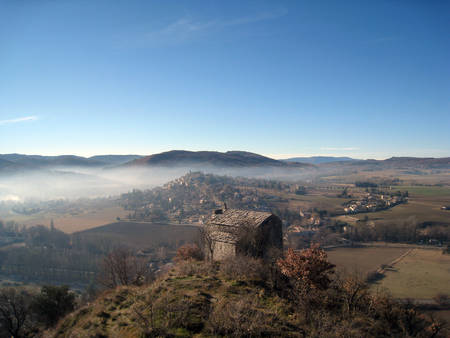“Footprints and fossil bones of primitive mammals are an important part of Luberon’s geoheritage”
Celebrating Earth Heritage
The Luberon UNESCO Global Geopark is located in the southeast of France, in the Provence region, close to the towns of Aix-en-Provence and Avignon.
Oligocene fossiliferous deposits are one of the major geological interests of this territory. Indeed, very thin platy limestones reveal a great variety of animal and plant fossils, which are well-preserved in sharp detail. Just like an open book, each thin lamina is like a photographic film preserving part of a several million-year-old environment. These superimposed plates have revealed an abundance of fish, leaves, insects, frogs, birds, tortoises and more. Other sites reveal fossil bones of primitive mammals (horses, elephants, and gazelles) but also footprints of rhinoceros, hyenas, young goats and birds. The landscapes of the Luberon constitute an important element of the geodiversity of this region. One of the most remarkable is the Ochre Massif, a protected area since 2002, which offers a landscape of cliffs and gullies, ranging in color from dark red to golden yellow. Similarly, the grey marl hills around the town of Apt are another unusual landscape, stratotype of the Aptian stage 120 million years ago. The exploitation of mineral resources (ochres, lignites, clays and limestones) has deeply marked the region and is attested by several ovens, quarries and factories. For the benefit of visitors, on-site information panels and information leaflets are available.
Sustaining local Communities
Corresponding to the Luberon Regional Nature Park area, it covers a surface of around 1,950 km² in Vaucluse and Alpes-de-Haute-Provence departments; it is inhabited by more than 174,000 people. The headquarter of the Geopark is located in the town of Apt, famous to be the world capital of candied fruits.
Scientific studies and excavation works are regularly carried out in partnership with universities. In this way, geology is valorized through on-site trips, teachers training, conferences, temporary exhibitions and also books aimed at the general public. Free educational activities are also offered to Luberon school classes.
The UNESCO Global Geopark management structure is the Luberon Regional Nature Park, classified by ministerial decree for a renewable term of twelve years. The Park missions assigned by law are: protection and management of natural, cultural and landscape heritage; regional planning; economic and social development; welcoming, education and public information; experimentation. The castle of the Environment, owned by Park, annually hosts many pupils who come to discover heritage with education professionals. More than 200 classes per year participate to the annual educational program of the Park on environment, energy, waste, water, geology, history topics. Many actions are also conducted for the general public like events, guided tours, exhibitions, conferences. The actions are based on a partnership with local stakeholders in education, tourism, promotion of agriculture and local products, development, economic development, protection and conservation of heritage in connection with local authorities.


